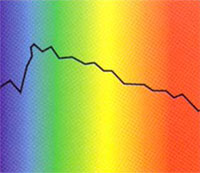Light Measurement for Controlling of Light Sources in the Quality Control
Light measurement - What is light?
For human eye, light and color is the visible area of electromagnetic radiation. Out of the complete spectrum of electromagnetic waves only the range between 380-780 nanometers (nm) of wavelength can be seen. Waves out of this range cannot be perceived as light or color. If every wavelength of the visible area has the same intensity then the light seems to be white. The lightness itself is determined by the total intensity of the light.
 Approximately 80% of all senses the human being has, are absorbed by the eyes. In order to fulfill the function of the eyes, they use light as a "mediator". Light and color belong together. Without light human beings cannot perceive colors. This is why a person needs a certain lighting level. Outdoors 5,000 lx are needed on a cloudy winter day, and about 100,000 lx on a sunny summer day. Indoors artificial lighting systems deliver only 100 to 1,000 lx.
Approximately 80% of all senses the human being has, are absorbed by the eyes. In order to fulfill the function of the eyes, they use light as a "mediator". Light and color belong together. Without light human beings cannot perceive colors. This is why a person needs a certain lighting level. Outdoors 5,000 lx are needed on a cloudy winter day, and about 100,000 lx on a sunny summer day. Indoors artificial lighting systems deliver only 100 to 1,000 lx.
Facts about light measurement
Used units:
Lighting level: Lux (lx). One lux is equal to one lumen per square meter
Luminous flux: Lumen (lm)
Available meters:
Luxmeter to determine the lighting level in lx
Chromameter to measure standard color value, color variation and lighting level of light sources
Light density to determine the luminance in cd/m²
Spectro-radiometer to measure spectral power distribution of light (e.g. the graphic above, standard light according to CIE)
UV radiometer to measure UV radiation in μW/cm²
